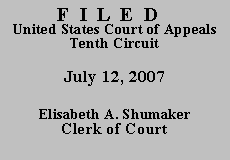

| UNITED STATES OF AMERICA, |
( 03-CR-102-HDC) |
Background
On September 29, 2003, Mr. McNack pleaded guilty to bank robbery in violation of 18 U.S.C. § 2113(a). Under the plea agreement Mr. McNack waived his rights to appeal, including the right to file habeas corpus petitions under 28 U.S.C. § 2255. He also stipulated that he was a career criminal under § 4B1.1 of the United States Sentencing Guidelines.
On January 6, 2004, Mr. McNack was sentenced to 178 months imprisonment, followed by three years of supervised release. On January 20, 2004, he filed notice of appeal to the Tenth Circuit, despite his waiver of appellate rights. Counsel for Mr. McNack filed an Anders brief, see Anders v. California, 386 U.S. 738 (1967), asserting there were no appealable issues and withdrawing from the case. We subsequently affirmed the conviction and sentence. Mr. McNack then filed a pro se § 2255 petition in district court, which was denied. He has now applied for a COA in this Court.
Discussion
The denial of a motion for relief under 28 U.S.C. § 2255 may be appealed only if the district court or this Court first issues a COA. Id. § 2253(c)(1)(B). A COA will issue "only if the applicant has made a substantial showing of the denial of a constitutional right." Id. § 2253(c)(2). To make such a showing, a petitioner must demonstrate that "reasonable jurists could debate whether . . . the petition should have been resolved in a different manner or that the issues presented were adequate to deserve encouragement to proceed further." Slack v. McDaniel, 529 U.S. 473, 483-84 (2000) (internal quotation marks omitted).
Mr. McNack raises two claims in his application for COA. First, he claims counsel was ineffective for refusing to object to inaccuracies in his presentence report. Second, he contends that his due process rights were violated because his presentence report was incorrect when he was sentenced, and that if it were corrected, he would not be classified as a career criminal. We can address both claims simultaneously. Even assuming arguendo there is an inaccuracy in the presentence report, it would not have any impact on Mr. McNack's 178-month sentence. Therefore, the existence of any such inaccuracy and the failure to object to it would amount at most to harmless error.
Mr. McNack has an extensive history of run-ins with the law. Starting at age 18, he accumulated over ten convictions for auto theft, larceny of automobile, failure to comply, knowingly concealing stolen property, possession of stolen vehicle after former felony conviction, breaking and entering, burglary, theft by taking, theft by receiving stolen property, possession of firearm after felony conviction, and escape. The district court treated two of these convictions, burglary and escape, as crimes of violence under U.S.S.G. § 2K2.1.
As the district court stated, the presentence report was corrected after sentencing in one respect: to show that Mr. McNack's Georgia burglary sentences were to run concurrently rather than consecutively. Mr. McNack claims that this inaccuracy at sentencing violated his due process rights. This change, however, had no effect on Mr. McNack's impending sentence, as he still retains two convictions for violent felonies.
Burglary is specifically mentioned in the Guidelines as a crime of violence. See U.S. Sentencing Guidelines Manual § 4B1.2(a)(2) (2003) ("The term "crime of violence" means any offense . . . that . . . is burglary . . . ."). The Guidelines do not specifically classify escape as a violent crime, and if this were a question of first impression we might well question whether all escapes fall within that category. But this and other courts have held "that an escape conviction 'by its nature . . . is properly characterized as a crime of violence,'" regardless of particular circumstances. United States v. Mitchell, 113 F.3d 1528, 1533 (10th Cir. 1997) (quoting United States v. Gosling, 39 F.2d 1140, 1142 (10th Cir. 1994)). Accord, United States v. Gay, 251 F.3d 950, 952, 954-55 (11th Cir. 2001) (citing cases from the 5th, 6th and 8th Circuits agreeing with this rule). Quite simply, Mr. McNack's counsel did not object to the defendant's classification as a career criminal because such an objection would have been futile. We therefore conclude that Mr. McNack has failed to make a "substantial showing" that his Sixth Amendment or due process rights were violated.
Conclusion
We DENY Mr. McNack's request for a COA and DISMISS this appeal.
Entered for the Court,
Michael W. McConnell
Circuit Judge
*.This order is not binding precedent, except under the doctrines of law of the case, res judicata, and collateral estoppel.